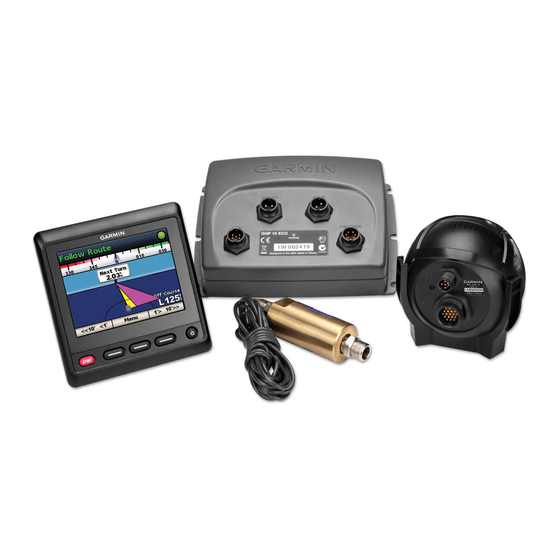Garmin GHP 10 Configuration Notes
Browse online or download pdf Configuration Notes for Marine GPS System Garmin GHP 10. Garmin GHP 10 14 pages. Autopilot system, addendum
Also for Garmin GHP 10: Installation Instructions Manual (48 pages), Installation Instructions Manual (26 pages), Owner's Manual (28 pages), Declaration Of Conformity (1 pages), Reference (1 pages)

Configuration Notes for the GHP
Use the included GHP 10 Installation Instructions to install your GHP 10 autopilot system. When you reach page 25 of the GHP 10 Installation
Instructions, refer to the notes in this document to achieve the best results with configuring and tuning the GHP 10.
The Sea-Trial Wizard
The Sea Trial Wizard configures the fundamental sensors on the autopilot, and it is extremely important to complete the wizard in conditions
appropriate for your boat. In general, it is highly recommended to complete the Sea Trial Wizard in calm water with little or no wind. Because
the nature of calm water is relative to the size and shape of your boat, be sure you choose a location where:
•
Your boat does not rock while sitting still or moving very slowly.
•
Your boat is not significantly affected by the wind.
While completing the Sea Trial Wizard in calm water, it is important to observe the following:
•
Keep the weight on your boat balanced. DO NOT move around on the boat while completing any of the steps in the Sea Trial Wizard.
•
Be sure that the engines are trimmed down, and that the trim tabs are up.
Planing RPM Note
If you have a displacement-hull boat, there will not be a transition point for you to set. Instead, adjust the Planing RPM to the highest possible
value (6000 RPM).
Compass Calibration Notes
Before you begin the compass calibration procedure, drive your boat in a slow, straight line, and wait for the wake generated by the previous
step to pass.
When you begin the procedure, turn the boat slowly clockwise, taking care to make as steady and flat a turn as possible. Turn slowly enough
that the boat DOES NOT list.
If you have a dual-engine boat, slowly run the port engine forward and the starboard engine in reverse to pivot on a stationary position.
Autotune Notes
Before you begin the Autotune procedure, adjust the throttle so that the boat travels at a constant RPM below planing speed, with enough speed
to maintain responsive steering. Select
in progress. When the GHC 10 displays a completion message, select Done. Be sure to take manual control of the boat when Autotuning is
complete.
If the Autotuning fails:
•
Increase the throttle approximately 200 RPM and select
•
If it fails again, continue retrying the process adding increments of 200 RPM.
•
If you reach planing speed through adding increments of 200 RPM and the autotune procedure continues to fail, reduce speed below
planing speed and select
CAuTiON: The Alternate Autotune is only applicable to a small number of boats, and should be the last attempt at autotuning. Do not perform the
Alternate Autotune until you are sure the standard autotune procedure will not work on your boat.
NOTE: If the autotune procedure continually fails, it is possible that air is present in the hydraulic system. It is also possible that a leak or other
problem exists in the hydraulic system. If you cannot complete the autotune procedure or the Alternate Autotune, check the hydraulic system on your
boat for leaks or other problems, and bleed it completely if necessary.
September 2008
Begin
when you are ready. The boat will perform a number of zigzag motions while the Autotuning is
Alternate Autotune
to begin an alternate autotuning procedure.
Addendum
10 Autopilot System
™
Retry
to begin the process again.
190-00894-06 Rev. A
Printed in Taiwan
